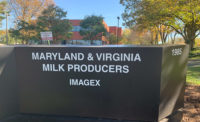Constantine, Mich., bills itself as the “seed corn capital of the world,” producing more than 10% of the United States’ supply. But this Southwest Michigan town hasn’t completely “gone to seed.” It also lays claim to a dairy processing powerhouse operated by the Novi, Mich.-based Michigan Milk Producers Association (MMPA). (See Processor Profile)
The plant traces its roots back to 1915, when it commenced operation as Constantine Cooperative Creamery. MMPA assumed ownership when the creamery merged with it in 1980.
MMPA’s 111,000-square-foot Constantine plant is able to process as much as 3 million pounds of milk per day, converting it into Grade A pasteurized condensed skim milk, cream/Grade A pasteurized heavy cream, nonfat dried milk powder, buttermilk milk powder, butter and pasteurized ultrafiltered skim milk concentrate.
Production takes place across three shifts, 365 days a year, the cooperative noted. The plant also has an 18,000-square-foot dry warehouse with two bays that operates one shift per day.
The ultrafiltered skim milk concentrate is the newest addition to the plant’s product lineup — and one that’s potentially game-changing. To produce the product, MMPA expanded the facility to add state-of-the-art ultrafiltration processing equipment, explained Dave Davis, plant manager.
The major expansion — funded in part through a $122,000 Michigan Business Development Program performance-based grant approved by the Lansing, Mich.-based Michigan Economic Development Corp. (MEDC) via the Michigan Strategic Fund — was completed in November 2018, following a fast-tracked six-month construction timeline.
The expansion, which MMPA dubbed “Project Extreme,” added 1.3 million pounds of dairy processing capacity and required the construction of 17 new silos, Davis said.
“The end product, which is low-carb, low-lactose and high-protein, can be used in dairy nutritional drinks, yogurt, cheese standardization and infant formula,” he noted. “We are working directly with customers to meet their specific needs with our customizable system.”
The expansion will also help manage the state of Michigan’s surplus of unprocessed milk, as well as elevate profitability within the Michigan dairy industry, said Jeff Mason, CEO of MEDC.
The road to ultrafiltered milk concentrate
Dairy Foods recently had the opportunity to tour the new ultrafiltered milk operations. Production begins with milk delivery from MMPA producers into the receiving area. From receiving, the milk enters the facility’s hub, where it is divided into three streams. One goes to the evaporator, one goes to reverse osmosis (RO) operations, and one goes to the ultrafiltered operations, Davis said.
The ultrafiltered stream then goes to a separator, where the cream is pulled off, pasteurized and conveyed to the butter-making department. (It’s worth noting that except for the main hub, every area dedicated to ultrafiltered milk production is brand new.)
The remaining milk then is transferred to a balance tank and then goes to a pasteurizer. After pasteurization, the milk is pumped into a tank to cool. It is next conveyed to the main ultrafiltration area.
“At this point, it is skim milk,” Davis explained.
In the ultrafiltration area, the milk passes through a vast series of membranes, which remove an ever-increasing amount of lactose/minerals and water. The finished ultrafiltered skim milk concentrate eventually flows out of the system and is conveyed into one of four silos in the staging area. From there, it is transferred into tanker trucks for customer delivery.
The facility currently fills four to six tanker truck loads a day with finished ultrafiltered milk concentrate, but has the capacity to process much more milk, Davis noted. To expand production, MMPA currently is working with customers on identifying new uses for the concentrate in innovative products. The plant even offers the product in 4-foot-by-4-foot liquid totes and 55-gallon drums for customer R&D purposes.
Meanwhile, the permeate leaves the ultrafiltration system on the opposite side of the milk concentrate’s exit point. It is then transferred to the
RO system, which separates the permeate from the water, Davis said. The condensed permeate is staged in one of several dedicated silos before being sent out of the facility for animal feed applications.
As for the water, it undergoes ultraviolet treatment before entering one of five storage silos. All of the water is repurposed for cleaning and processing applications within the plant, Davis noted.
Ultrafiltration room operations are highly automated, requiring only one operator per shift. And there are other state-of-the-art touches. The air flow is controlled so it is greatest in the center of the room, Davis explained, and HEPA-filtered air is directed upward to prevent the flow of dirty air into the area.
In addition, a transition room boasts a large antimicrobial mat instead of a traditional foot bath. Employees must walk across it before entry to the main ultrafiltration room.
Eye on employee safety
Whether working on the ultrafiltered milk side or in one of the many other areas of the facility, the Constantine plant’s 56 employees are trained to keep their own — and others’ — safety top of mind. All employees are trained thoroughly on the safe operation of plant equipment, Davis said, and also receive annual refresher training.
“The plant holds quarterly safety training sessions to ensure employee safety,” he added. “We ensure proper personal protective equipment use when required [and have] catwalks with safety rails.”
And to enhance both efficiency and productivity, team members are cross-trained to run various lines and equipment, Davis added.
Food safety, quality are musts
Food safety and quality are critical concerns, too. The SQF Level 3-certified plant adheres to FDA’s Food Safety Modernization Act guidelines.
“Food safety plans that cover chemical, microbiological and physical hazards and their mitigation have been developed and implemented for all product lines,” explained Sudeep Jain, MMPA’s director of quality. “Raw milk is covered by the Pasteurized Milk Ordinance of the FDA. Good manufacturing practices are followed across the plan to ensure safe food production.”
Before a product can be shipped to customers, it must meet the plant’s criteria for both food safety (microbiological safety) and food quality (the right levels of components and the desired functionality), he noted. Therefore, the plant monitors product safety and quality during the processing stage by regularly drawing samples for testing.
Chemistry testing is performed hourly for liquid products to ensure they meet specifications, Davis said, and composition testing is performed hourly on powdered milk as well.
“Butter sub-lots — every 72 cased — are sampled throughout production and tested for butterfat, moisture and salt,” he noted. “Shelf-stable products are sampled every sub-lot and composited for final testing. The quality assurance department reviews all testing and will release [products] after verifying testing meets specifications.”
Component and indicator organism testing are performed in an in-house lab, while pathogen testing is outsourced, Jain explained.
The facility also tests finished liquid products that are shipped in bulk tankers as ingredients for chemistry and microorganisms, Davis noted. Shelf-stable products such as butter and milk powders undergo testing at an approved third-party laboratory for pathogens and additional chemistry.
“Shelf-stable products are placed on hold and not released until pathogen tests results are found to meet specifications and reviewed by the QA department,” he said.
Food safety is a focus on the supplier side, too. The Constantine facility has a supplier approval program that calls for documentation of suppliers’ third-party audits, letters of guarantee, chains of custody and certificates of analysis, Davis said. When appropriate, it also requires documentation of kosher and halal certificates, good manufacturing practices and regulatory inspection reports.
Sustainability is a priority
Sustainability is also an important component of the plant’s operation. After all, MMPA’s sustainability mission calls for the cooperative “to continually strive for a more sustainable future — for our community, our environment, our economy’s health, and for the lives and world around us,” said Sheila Burkhardt, MMPA’s senior director of member and government relations.
The cooperative is part of the U.S. Dairy Sustainability Alliance, she noted, and works with other dairy industry stakeholders “to measure, improve and communicate dairy’s role in a sustainable food system.” That work extends throughout MMPA’s supply chain — to the farms and to the processing plants, including the Constantine facility.
That’s why sustainability and efficiency were major priorities when it came to the design of the new ultrafiltered milk operations. The ultrafiltration system has a small carbon footprint, with energy-efficient equipment and lighting, Davis pointed out.
“We are also recycling water,” he said. “The ultrafiltration plant can generate up to 85,000 gallons of pasteurized equivalate water per day. We use the clean water to clean and operate the ultrafiltration system,” Davis noted.









